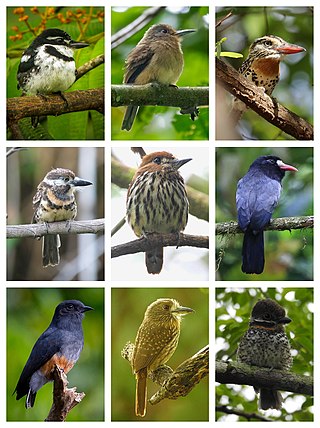
The puffbirds and their relatives in the near passerine family Bucconidae are tropical tree-dwelling insectivorous birds that are found from South America up to Mexico. Together with their closest relatives, the jacamars, they form a divergent lineage within the order Piciformes, though the two families are sometimes elevated to a separate order Galbuliformes. Lacking the iridescent colours of the jacamars, puffbirds are mainly brown, rufous or grey, with large heads, large eyes, and flattened bills with a hooked tip. Their loose, abundant plumage and short tails makes them look stout and puffy, giving rise to the English name of the family. The species range in size from the rufous-capped nunlet, at 13 cm (5.1 in) and 14 g (0.49 oz), to the white-necked puffbird, at up to 29 cm (11 in) and 106 g (3.7 oz).

The brown-headed barbet is an Asian barbet species native to the Indian subcontinent, where it inhabits tropical and subtropical moist broadleaf forests.

The bearded barbet is an African barbet. Barbets are birds with a worldwide tropical distribution, although New World and Old World barbets are placed in different families. The barbets get their name from the bristles which fringe their heavy bills.
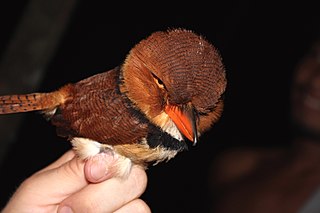
Bucco is a genus of birds in the puffbird family Bucconidae. Birds in the genus are native to the Americas.

The sooty-capped puffbird is a species of bird in the family Bucconidae, the puffbirds, nunlets, and nunbirds. It is endemic to Colombia.

The spotted puffbird is a species of puffbird in the family Bucconidae, the puffbirds, nunlets, and nunbirds. It is found in Bolivia, Brazil, Colombia, Ecuador, French Guiana, Guyana, Peru, Suriname, and Venezuela.

The white-chested puffbird is a species of bird in the family Bucconidae, the puffbirds, nunlets, and nunbirds. It is one of seven species in the genus Malacoptila. It is found in Brazil, Colombia, Ecuador, French Guiana, Guyana, Peru, Suriname and Venezuela.
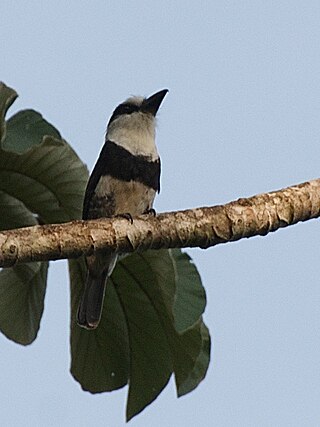
The white-necked puffbird is a species of bird in the family Bucconidae, the puffbirds, nunlets, and nunbirds. It is found in Mexico, Central America, Bolivia, Brazil, Colombia, Ecuador, Peru, and Venezuela.
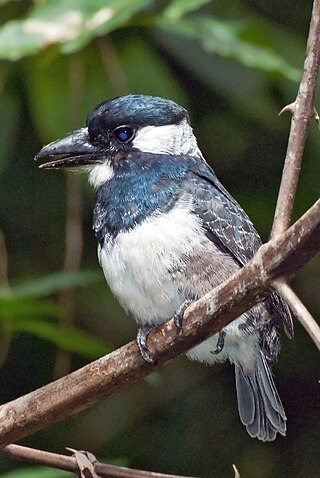
Notharchus is a genus of puffbird in the Bucconidae family.

The black-breasted puffbird is a species of bird in the family Bucconidae, the puffbirds, nunlets, and nunbirds. It is found in Colombia, Ecuador, and Panama.

The buff-bellied puffbird is a species of bird in the family Bucconidae, the puffbirds, nunlets, and nunbirds. It is found in Argentina, Brazil, and Paraguay.

The pied puffbird is a species of bird in the family Bucconidae, the puffbirds, nunlets, and nunbirds. It is found in Bolivia, Brazil, Colombia, Costa Rica, Ecuador, French Guiana, Guyana, Nicaragua, Panama, Peru, Suriname, and Venezuela.

Nystalus is a genus of puffbirds in the family Bucconidae.

The Caatinga puffbird is a species of bird in the family Bucconidae, the puffbirds, nunlets, and nunbirds. It is endemic to Brazil.
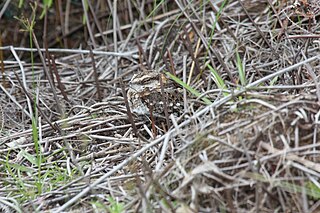
The white-tailed nightjar is a species of nightjar in the family Caprimulgidae. It is found in the tropic regions of Central and South America.

The chestnut-belted gnateater is a species of bird in the family Conopophagidae, the gnateaters. It is found in the Amazon Basin of northern Brazil, southern Colombia and eastern Peru and Ecuador; also the Guianan countries of Guyana, Suriname and eastern French Guiana. Its natural habitat is tropical moist lowland forest.

The whiskered myiobius or bearded flycatcher is a species of bird in the family Tityridae, having previously been included in Tyrannidae. A number of taxonomic authorities continue to place with the flycatchers. The whiskered myiobius is found in Brazil, Colombia, Ecuador, French Guiana, Guyana, Peru, Suriname, and Venezuela. Its natural habitats are subtropical or tropical moist lowland forests and heavily degraded former forest.

The black-headed antbird is a species of passerine bird in the antbird family Thamnophilidae. It is found in Brazil, Colombia, French Guiana, Guyana, Peru, Suriname, and Venezuela. Its natural habitat is subtropical or tropical moist lowland forests.

The coraya wren is a species of bird in the family Troglodytidae, the wrens.

Galbuli is one of the two suborders of the order Piciformes. It includes two families, Bucconidae (puffbirds) and Galbulidae (jacamars), both restricted to the Neotropics.





















